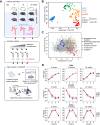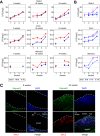Compartment-resolved Proteomic Analysis of Mouse Aorta during Atherosclerotic Plaque Formation Reveals Osteoclast-specific Protein Expression
- PMID: 29208753
- PMCID: PMC5795394
- DOI: 10.1074/mcp.RA117.000315
Compartment-resolved Proteomic Analysis of Mouse Aorta during Atherosclerotic Plaque Formation Reveals Osteoclast-specific Protein Expression
Abstract
Atherosclerosis leads to vascular lesions that involve major rearrangements of the vascular proteome, especially of the extracellular matrix (ECM). Using single aortas from ApoE knock out mice, we quantified formation of plaques by single-run, high-resolution mass spectrometry (MS)-based proteomics. To probe localization on a proteome-wide scale we employed quantitative detergent solubility profiling. This compartment- and time-resolved resource of atherogenesis comprised 5117 proteins, 182 of which changed their expression status in response to vessel maturation and atherosclerotic plaque development. In the insoluble ECM proteome, 65 proteins significantly changed, including relevant collagens, matrix metalloproteinases and macrophage derived proteins. Among novel factors in atherosclerosis, we identified matrilin-2, the collagen IV crosslinking enzyme peroxidasin as well as the poorly characterized MAM-domain containing 2 (Mamdc2) protein as being up-regulated in the ECM during atherogenesis. Intriguingly, three subunits of the osteoclast specific V-ATPase complex were strongly increased in mature plaques with an enrichment in macrophages thus implying an active de-mineralization function.
© 2018 by The American Society for Biochemistry and Molecular Biology, Inc.
Figures





References
-
- WHO. Cardiovascular diseases (CVDs). 2017; Available from: http://www.who.int/mediacentre/factsheets/fs317/en/.
-
- Kannel W. B., Wolf P. A., and Verter J. (1983) Manifestations of coronary disease predisposing to stroke. The Framingham study. JAMA 250, 2942–2946 - PubMed
-
- Iso H., Jacobs D. R. Jr., Wentworth D., Neaton J. D., and Cohen J. D. (1989) Serum cholesterol levels and six-year mortality from stroke in 350,977 men screened for the multiple risk factor intervention trial. N. Engl. J. Med. 320, 904–910 - PubMed
-
- Sacco R. L., Benjamin E. J., Broderick J. P., Dyken M., Easton J. D., Feinberg W. M., Goldstein L. B., Gorelick P. B., Howard G., Kittner S. J., Manolio T. A., Whisnant J. P., and Wolf P. A. (1997) American Heart Association Prevention Conference. IV. Prevention and Rehabilitation of Stroke. Risk factors. Stroke 28, 1507–1517 - PubMed
-
- Dichgans M., Malik R., Konig I. R., Rosand J., Clarke R., Gretarsdottir S., Thorleifsson G., Mitchell B. D., Assimes T. L., Levi C., O'Donnell C. J., Fornage M., Thorsteinsdottir U., Psaty B. M., Hengstenberg C., Seshadri S., Erdmann J., Bis J. C., Peters A., Boncoraglio G. B., Marz W., Meschia J. F., Kathiresan S., Ikram M. A., McPherson R., Stefansson K., Sudlow C., Reilly M. P., Thompson J. R., Sharma P., Hopewell J. C., Chambers J. C., Watkins H., Rothwell P. M., Roberts R., Markus H. S., Samani N. J., Farrall M., and Schunkert H. (2014) Shared genetic susceptibility to ischemic stroke and coronary artery disease: a genome-wide analysis of common variants. Stroke 45, 24–36 - PMC - PubMed
Publication types
MeSH terms
Substances
LinkOut - more resources
Full Text Sources
Other Literature Sources
Molecular Biology Databases
Miscellaneous

